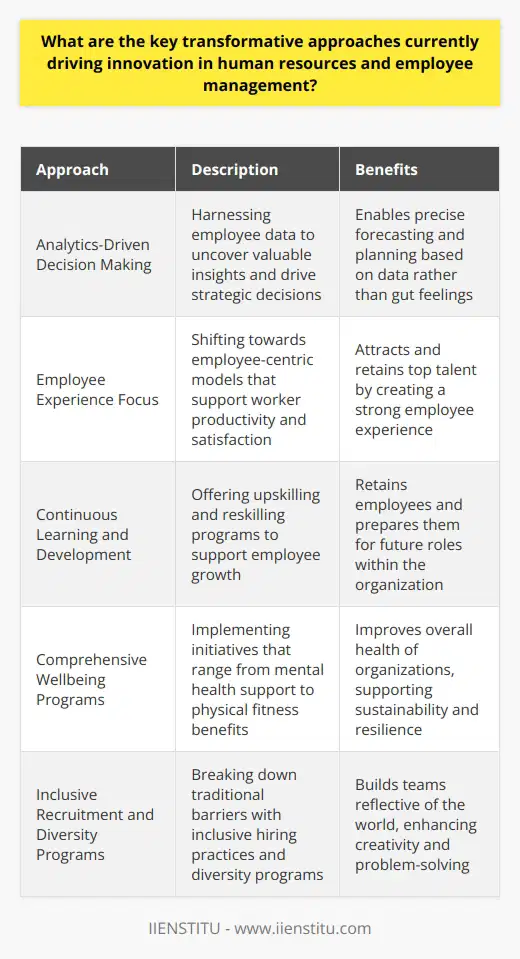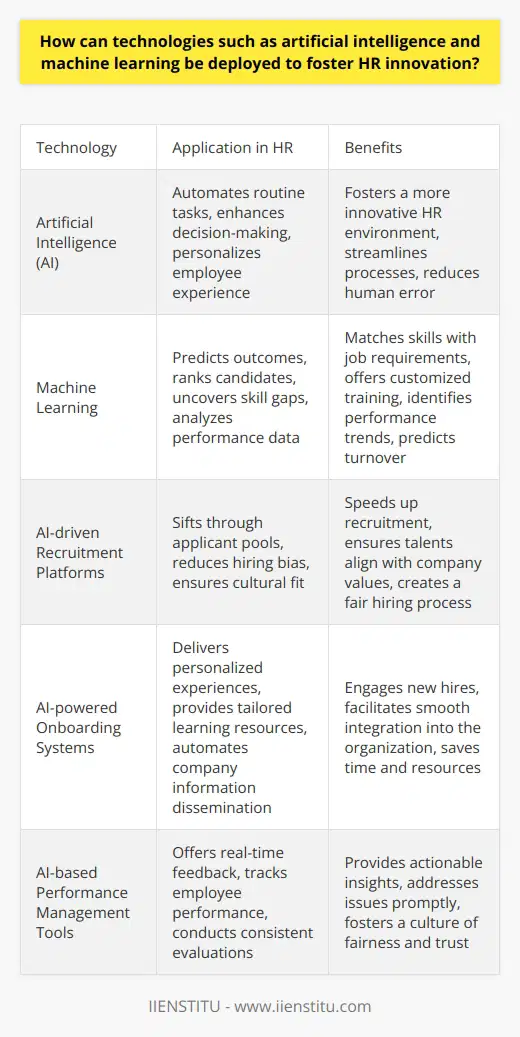
In the rapidly evolving landscape of the modern workplace, human resource (HR) departments are becoming pivotal architects of business success. As digitization accelerates and the workforce diversifies, HR professionals seek innovative practices to manage their most valuable assets – their employees.
This article delves into the transformative approaches in employee management that are redefining how organizations operate, engage talent, and sustain competitive advantage. Emphasis is placed on human resources certification course and online certification courses as tools for HR practitioners to gain comprehensive knowledge and keep pace with the latest industry trends. The ensuing discussion encapsulates the essence of HR innovation, its importance, and practical strategies for implementation, supplemented by real-life examples and predictions on the future of HR innovation.
Introduction to HR Innovation
HR innovation pertains to the implementation of new ideas, methods, and technologies to enhance the effectiveness of HR functions and contribute to overall organizational excellence. In the context of our contemporary digital age, where agility and adaptability are paramount, HR innovation serves as a cornerstone for businesses to thrive amidst relentless change. This blog will explore the facets of HR innovation, illuminating why it is fundamental for organizational resilience and prosperity.
In dynamic business environments, companies cannot afford stagnation. HR innovation plays a pivotal role in enabling organizations to navigate the complexities of modern business landscapes. It allows HR departments to streamline processes, enhance communication and harness the potential of data analytics for informed decision-making. The impending discussion will reveal how HR innovation is not merely a trend but a strategic imperative.
Approaching HR innovation requires a proactive stance towards emerging opportunities and challenges within the realm of people management. In this blog, an overview of HR innovation's facets – from digital transformation and emerging trends to practical implementation and insightful case studies – will provide readers with a comprehensive understanding of how to strategically overhaul HR practices to align with today's business needs and tomorrow's aspirations.
The Importance of HR Innovation
HR innovation has emerged as a critical factor in bolstering a business's growth trajectory and securing its long-term viability. By implementing innovative HR practices, companies can effectively navigate the complexities of workforce management, resulting in enhanced growth and profitability. HR departments must thus continually adapt and evolve to meet the dynamic needs of both the organization and its employees.
Innovative HR practices can significantly elevate productivity and efficiency. By leveraging advanced HR technologies and methodologies, HR professionals can optimize recruitment processes, improve employee engagement, and facilitate continuous learning and development. These innovations prove instrumental in aligning employee objectives with corporate goals, thereby driving collective success.
The pull of HR innovation also extends significantly into the arenas of talent acquisition and retention, areas that are highly competitive and critical for business success. Companies that exhibit a genuine commitment to innovation are more likely to attract top talent who value forward-thinking and personal growth opportunities. By incorporating compelling real-life examples, it becomes clear that HR innovation is a magnet for high-caliber professionals and is essential in maintaining a vigorous and dedicated workforce.
Adaptability in Human Resources Management: What Does it Mean?
Career Path: Navigating Progression and Promotion Strategies
HR Innovation and Digital Transformation
HR innovation and digital transformation go hand in hand, as the latter serves as an enabler for the former. In today's digitized business environment, HR departments must leverage technology to facilitate and drive innovation, thus securing a competitive edge for their organizations. Technology in HR ranges from cloud-based HR systems to AI-powered analytics, fundamentally transforming how HR services are delivered and experienced.
The influx of technology into HR practices allows for a more strategic approach to managing human capital. Tools such as data analytics enable HR professionals to make evidence-based decisions, enhancing their strategic influence within the organization. Additionally, automation of routine tasks liberates HR practitioners to focus on more strategic initiatives, such as workforce development and employer branding.
Technological advancements in HR also facilitate innovative practices by streamlining communication, fostering remote collaboration, and promoting a more flexible work environment. In an age where work-from-home arrangements have become prevalent, technology ensures that HR functions can adapt and thrive in an increasingly virtual workplace.
HR Innovation Trends
An analysis of current trends in HR innovation reveals a compelling transformation of the HR landscape. These trends are reshaping practices across various HR functions, from performance management to employee wellness. For instance, personalized employee experiences, data-driven decision-making, and an emphasis on well-being and inclusivity are becoming increasingly prevalent in progressive HR departments.
As organizations grapple with evolving work dynamics, trends such as remote working technologies, wellness programs, and diversity, equity, and inclusion (DEI) strategies are becoming integral to an innovative HR approach. These trends mirror the changing expectations of the workforce and the impetus for companies to adapt for sustained engagement and productivity.
Insights into future HR innovation trends are pivotal for business leaders and HR practitioners. Anticipated developments suggest a continued tilt towards technology-enabled HR solutions, a greater focus on employee experience, and the integration of artificial intelligence in talent management practices. Understanding these trends is essential for future-proofing HR strategies.
Implementing HR Innovation
Implementing HR innovation within an organization is a strategic endeavor that requires a thoughtfully planned approach. It involves assessing current HR practices, envisioning desired outcomes, and executing changes in alignment with the organization's culture and objectives. Success in this realm requires not only technological upgrades but also an unwavering commitment to fostering a culture that embraces change.
The cultural aspect of an organization significantly influences the scope and success of HR innovation. Cultivating a culture that encourages experimentation, learning, and open communication lays the groundwork for innovation to flourish. HR leaders must actively champion this culture, leading by example and providing the necessary support for teams to experiment with new ideas and solutions.
Creating an enabling environment for HR innovation also involves equipping HR professionals with the necessary skills and knowledge. Pursuing a human resources certification course or engaging in relevant online certification courses can be instrumental in keeping HR teams at the forefront of industry developments, ensuring they have the expertise to drive innovation effectively.
Overcoming Challenges Associated with HR Innovation
Undertaking HR innovation is not without its challenges, as resistance to change and limited resources can often hinder progress. Identifying common obstacles in the HR innovation journey is the first step toward addressing them. These may include misalignment between HR objectives and overall business strategy, legacy systems that stifle new initiatives, and a lack of stakeholder buy-in.
Strategies for overcoming these challenges emphasize the importance of clear communication, alignment of innovation initiatives with business goals, and securing executive sponsorship. When employees understand the purpose and benefits of innovations, and top management endorses them, the implementation process becomes smoother, and the likelihood of success increases.
Maintaining the momentum of HR innovation over the long term also requires a deliberate structure to nurture and evaluate innovative projects. This might involve setting up innovation labs or task forces focused on continuous improvement, rewarding creative contributions, and analyzing the impact of innovation initiatives on organizational performance.
Case Studies of Successful HR Innovation
The case studies of businesses that have effectively executed HR innovation serve as blueprints for understanding the tangible impacts of such initiatives. These examples typically showcase a blend of strategic vision, decisive leadership, and an inclusive approach to people management, all of which contribute to significant positive changes within the organization.
A detailed examination of successful HR innovation reveals a pattern of increased employee satisfaction, higher productivity, and enhanced employer branding. Organizations that have embraced HR innovation report a more agile workforce that rapidly adapts to market changes, leading to greater operational efficiency and a stronger competitive position.
Lessons drawn from these case studies are invaluable, demonstrating that while the journey of HR innovation may vary across organizations, the principles of creativity, strategic integration, and employee empowerment remain constant. These insights offer inspiration and guidance for other businesses seeking to embark on their own HR innovation journey.
Future of HR Innovation
The field of HR innovation is poised to keep evolving, driven by technological advancements and changing workforce expectations. Predicted changes underscore a heightened focus on employee experience and performance analytics, along with an increased reliance on artificial intelligence to augment human decision-making.
HR innovation has the potential to shape the future of work significantly, impacting not only how work is performed but also the various facets of employee engagement, leadership development, and organizational culture. As HR continues to become more data-driven and employee-centric, companies that proactively adapt will likely emerge as industry leaders.
Concluding thoughts on the evolution of HR innovation point to a continuous journey rather than a finished destination. As businesses evolve and new technologies emerge, HR innovation will persist as an ongoing process of transformation and improvement, always striving to align human capital with the ever-changing demands of global business landscapes.
This article has systematically explored the diverse elements of HR innovation – from its fundamental importance in today's business world to the actionable strategies companies can employ in pursuit of innovation. It has underscored the significance of a culture that supports change and the instrumental role of ongoing education through opportunities like human resources certification course and online certification courses.
Business leaders are encouraged to recognize the transformative power of HR innovation and to embrace such practices as a means to excel in an increasingly competitive and complex business environment. This call to action extends not only to adopting new technologies and workflows but also to fostering an atmosphere in which employees can thrive and innovate.
Readers seeking to delve deeper into the intricacies of HR innovation and its application in their professional contexts are invited to engage in further reading and discussions. By doing so, they can contribute to a vibrant community of HR innovators, who together are setting the scene for the workplaces of the future.
Frequently Asked Questions
What are the key transformative approaches currently driving innovation in human resources and employee management?
Transforming Human Resources Management
Human resources (HR) stand at a crossroads. Innovations influence how companies manage and empower their workforce. Several key approaches are reshaping the HR landscape.
Analytics-Driven Decision Making
Data no longer sleeps in silos. HR analytics harness employee data. It uncovers valuable insights. These insights drive strategic decisions. Managers now forecast and plan with precision. They base complex choices on data, not gut feelings.
Employee Experience Focus
Workplaces shift towards employee-centric models. A strong employee experience attracts top talent. It retains them too. Companies invest in environments that support workers. They look for an intersection between productivity and satisfaction.
Continuous Learning and Development
Growth fuels the modern workforce. Continual development ranks high. Employers offer upskilling and reskilling programs. This commitment to growth retains employees. It prepares them for future roles.
Comprehensive Wellbeing Programs
Holistic health matters. Employers realize the value of wellbeing initiatives. These range from mental health support to physical fitness benefits. Such programs improve the overall health of organizations. They support sustainability and resilience.
Flexibility and Remote Work Options
Work-life balance evolves. Flexible schedules and remote work are now standard. They address the employee's need for balance. These practices also widen talent pools. They unlock potential from all corners of the globe.
AI and Automation Integration
Technology advances rapidly. Artificial intelligence (AI) and automation take over mundane tasks. They allow HR professionals to focus on strategic roles. They provide employees with self-service options. This fosters empowerment.
Inclusive Recruitment and Diversity Programs
Diversity drives innovation. Inclusive hiring practices break down traditional barriers. They build teams reflective of the world. Diversity programs support this variety. They enhance creativity and problem-solving.
Real-time Feedback Mechanisms
Annual reviews become obsolete. Instant feedback tools capture insights continuously. They align employee goals with company objectives. Workers improve consistently. Managers address issues swiftly.
Agile HR Teams
Flexibility does not only apply to work hours. Agile HR teams adapt quickly to changes. They respond to business needs immediately. This agility supports employee and organizational agility.
Strategic HR Business Partnering
HR shifts from administrative roles to strategic ones. HR business partners work closely with leaders. They provide insights that shape the organisation's future. Their strategic involvement elevates the role of HR.
In conclusion, these transformative approaches in human resources foster cultures of continuous innovation. They emphasize the importance of data-driven decision-making, employee wellbeing, and flexible, inclusive workplaces. Such environments attract and retain talent, drive performance, and ensure that organizations constantly adapt to the evolving business landscape.

How can technologies such as artificial intelligence and machine learning be deployed to foster HR innovation?
Artificial Intelligence in HR
Artificial intelligence (AI) transforms HR practices. It automates routine tasks. AI also enhances decision-making. Machine learning, a subset of AI, predicts outcomes. These technologies personalize the employee experience. They foster a more innovative HR environment.
Recruitment and Onboarding
AI speeds up recruitment. It sifts through vast applicant pools. Machine learning algorithms rank candidates. They match skills with job requirements. These technologies reduce hiring bias. They ensure talents fit the company culture.
Onboarding becomes streamlined. AI-driven platforms engage new hires. They deliver personalized experiences. Newcomers access tailored learning resources. They receive automated yet relevant company information.
Training and Development
Machine learning uncovers skill gaps. It offers customized training programs. Employees develop skills needed for their roles. AI supports career path planning. It guides employees through possible growth trajectories.
AI facilitates continuous learning. It provides on-demand training. It adapts to individual learning paces. Microlearning becomes possible. Employees absorb information in small, manageable chunks.
Performance Management
AI offers real-time feedback. It tracks employee performance. Machine learning analyzes this data. It identifies performance trends. Employers receive actionable insights. They can address issues promptly.
Fair performance assessments emerge. AI reduces human error in evaluations. It ensures consistency in reviews. Employees trust the process more. This fosters a culture of fairness.
Employee Engagement
AI gauges employee sentiment. It analyzes communication patterns. It detects morale changes. Employers intervene proactively. They address concerns before they escalate.
Machine learning predicts turnover. It identifies at-risk employees. Employers can then take preventive action. They implement retention strategies. This reduces turnover rates.
HR Analytics
AI-powered analytics transform HR into a strategic partner. Data-driven decisions become the norm. HR finds patterns in employee data. They address workforce challenges.
Predictive analytics forecast future trends. They anticipate hiring needs. They identify potential skill shortages. HR can plan accordingly.
AI and machine learning in HR are not distant futures. They are here. They foster innovation. They streamline processes. They make HR more strategic, fair, and employee-centric. As technology advances, so too will the potential for HR innovation. We must embrace these tools. They will shape the future of human resources.

In what ways does HR innovation contribute to overall organizational effectiveness and business strategy?
HR Innovation and Organizational Effectiveness
Innovation in Human Resources (HR) plays a pivotal role. It drives organizational effectiveness. It aligns with business strategy solidly. Companies must adapt swiftly in today's dynamic markets. HR innovation becomes a catalyst for such agility.
Strategic Recruitment
Innovative recruiting strategies identify and attract top talent. Strong candidates boost competitiveness. They offer fresh perspectives and novel skills. This enhances organizational capability. It positions the company for future success.
Data-Driven Decision Making
HR analytics harness big data. They optimize the decision-making process. HR professionals analyze workforce data to gain insights. These insights shape better strategies. They lead to informed, strategic decisions. This supports both short-term and long-term objectives.
Enhanced Performance Management
Innovative performance management systems focus on continuous feedback. Traditional annual reviews no longer suffice. Regular feedback fosters a growth mindset. It cultivates a culture of ongoing improvement. Employees align their goals with company strategy. Productivity increases. The company thrives.
Employee Engagement and Satisfaction
Engagement strategies foster a positive work environment. Satisfied employees tend to stay longer. They also perform better. Innovation in engagement tools can measure and improve job satisfaction. This reduces turnover costs. It contributes to a better employer brand. Attractive employer brands draw in talent.
Streamlined HR Processes
Automation and artificial intelligence streamline HR tasks. They reduce administrative burdens. HR professionals focus on strategic roles instead. Efficient processes save time and money. Resources redistribute towards innovation and growth. HR becomes a strategic partner. It supports business objectives more effectively.
Learning and Development
Continuous learning and development are essential. They ensure that employees' skills remain relevant. Innovative learning platforms offer personalized experiences. Employees engage in their development. They contribute to the company's adaptive capability. Skilled workers adapt to market changes quickly.
Collaborative Work Environment
HR innovation can foster collaboration. Cross-functional teams result from this. They break down silos. Information flows smoothly. Departments align their goals. Harmony within the organization aids in achieving strategic vision.
Diversity and Inclusion
HR plays a key role in building inclusive workplaces. Diverse teams offer broad perspectives. They are the source of creativity. An inclusive culture acts as a key differentiator. It drives innovation inside the organization. It mirrors a diverse customer base outside.
Flexibility and Work-Life Balance
Innovative HR policies offer flexibility in work schedules. They lead to better work-life balance. Employees appreciate such policies. They feel valued. This can lead to increased loyalty. A loyal workforce can better execute the business strategy.
Brand Reputation and CSR
HR innovation reinforces corporate social responsibility (CSR). Ethical employment practices define brand reputation. Positive reputation wins customer loyalty. It also attracts talent. Responsible brands stand out. They fare better in competitive markets.
In conclusion, HR innovation covers many grounds. It propels an organization forward. It fine-tunes the link between human capital and business strategy. HR innovation proves invaluable. It is not merely an operational necessity. It stands as a strategic imperative.



